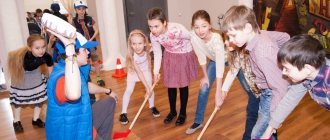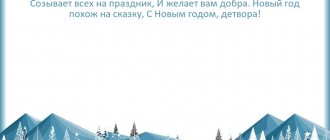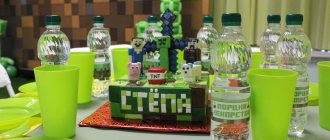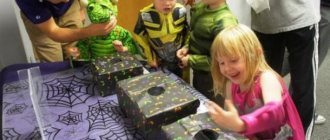The human mind is designed in such a way that everything secret and unexplored is a fascinating mystery for it. And this mystery subconsciously draws you into the cycle of events where such things as risk, fear and adventure are inherent. But not everyone is destined to become secret agents or spies in order to realize their desires and get at least a little closer to the “secrets of the world.”
Many children at an early age begin to become interested in screen heroes, such as James Bond, Mata Hari and others. Boys want to be like their favorite heroes, and girls secretly dream of such a guy or husband. That's why they try to play similar games and fight criminals. But few people know that the work of secret spies and agents is not just shootouts and chases. Their work can be called more intellectual and mental. Therefore, if you organize a spy-themed party for children, they will be very happy. First you need to write invitations in the appropriate style. This can be done in the form of an agenda.
Invitation - Party summons
Invitation text:
"Top secret".
According to the law (of a certain intelligence agency), we notify you (guest name) about the beginning of an investigation. We invite you to appear at the specified address (address and time of the party). We take promises of non-disclosure from you. Violations of confidentiality and secrecy will result in removal from the case file.
At the bottom of this text you can list the necessary accessories and items that will be needed to begin the investigation. These could be wigs, hats, sunglasses. This is the minimum that will be needed for the party. But, everything else will have to be completed by the parents themselves. It may be that not all guests will be able to get the necessary accessories, and therefore you need to stock up on the necessary details yourself.
A children's pirate party will please your child.
Examination
Props : exam tickets, tickets with the inscription “learned”, stamp.
Assignment : all arriving teams draw tickets. The task is to write the correct answers. You can be wrong no more than three times. If a team answers incorrectly, it draws a new ticket. No one should stay at the station for more than 20 minutes.
All tickets are built on the same principle: you need to list ten something: commandments, the largest cities of Russia, Asian countries, wars of the 19th century, heads of state - you can continue ad infinitum.
After successfully passing the exam, you are issued a certificate with the inscription “Learned” and a stamp.
Accessories for spies
An important attribute of every spy is his secret agent identification card. It can be made from white cardboard in the form of badges. On the card you should write: “Agent 001 of the highest category,” assign code 002 of the extra category to the next child, and so on. To fully identify each agent, you can invite children to leave their fingerprint on the badge. For this purpose you will need black gouache. With its help you can make a good fingerprint. Each agent must also have his own nickname. We also write it on the card. Suitable nicknames for this include “black cloak”, “invincible”, “sharp ear”, “super smart”, “cunning dog”. Guests place badges on their chests.
As for the rest of the necessary details for a real spy, you will need a magnifying glass, individual bags or folders. Also several notebooks and pens. You can purchase special sets in toy stores that contain everything necessary for detectives.
What kind of theme parties are there?
Station 1. Get out of the room
Space : an office or other place with a narrow entrance/exit.
Necessary props : photograph (in our case, this is a special photograph of a mushroom with a sewn-in geo-tag).
The presenter reads out the text of the task :
Welcome to Scout School. Your task is to consistently complete tasks and reach a goal that may not seem obvious to you now. Actually, the first task has already been delivered to you. Your task is to find out the country in which this photograph was taken. By writing the password on a piece of paper and handing it to the guard, you can leave the premises and begin the task. Not far from the audience there is a key that will tell you where to go.
Before starting the game, in an event group on a social network or in another logical and obvious place to search, publish a photo with a geotag that can be used to determine where it was taken. If you can't find a photo, take ours. Important: Do not post the geotag next to the photo. If participants don't know how to look for geotags in metadata, remind them to Google it.
The correct answer if you are using our photo is Canada
Room decoration
Before decorating a room, you also need to take it seriously. All attributes must match the style of the party. The walls of the apartment can be decorated with posters from movies about spies. On the table where the game “investigations” will be carried out, you can put notes with randomly scattered numbers, metal coins, counterfeit bills, several old books (about spies), and paper folders. By the way, you can put criminal dossiers in these folders. To do this, you should type on the computer several profiles of unknown personalities with pseudonyms (an insidious player, a big villain, an unknown thief). These dossiers will simply play the role of props. But, you need to make a second dossier. They will be needed to conduct an investigation in the form of a game.
Invitations
The real spy invitation can be printed from the Internet. Or you can do it yourself:
- false passport, pass, note from an informant, etc.
- postcard in the shape of a hat, mask, gun, spy silhouette.
The information in the invitation must be written in “agent” language: top secret, the informant informed the time and place of the meeting, disguise is required. Give your party guests nicknames. For security purposes, encrypt the review password: anagram, rebus, phrase backwards.
Games and competitions
The beginning of fun games can be the game: secret dossier.
To conduct this competition, you will need folders with pre-compiled dossiers for each participant. The dossier should be written wittily and concisely. You take turns reading out information about each “agent”, and the children guess who it is. Approximately, each individual questionnaire may contain the following information:
“A true fighter for justice, talented in studying school subjects. A special feature of this is systematically being late for school events. Excessive talkativeness is a bad habit.”
“His main principle is the reluctance to study for straight A’s. Often seen in the school canteen, as a true gourmet who believes that there is no such thing as too much food. Special features: always a smug face, a confident look. It’s not a very useful habit to fall asleep in class.”
“Hooligan character, persistent and constant in his habits - skipping classes. Special features: forgets to take books and notebooks to lessons. Often seen communicating with the weaker sex.” This competition is very psychological from a psychological point of view and helps children develop their thinking and teaches them to better understand people.
Analyst competition
A real agent must have an analytical mind and master the method of deduction. The heroes of the party will also be able to test their strength in this competition.
Children are divided into two teams. Give each guest a clean sheet of paper, lemon juice and brushes. They must use brushes to write riddles you have prepared in advance for the opposing team. After the written letters dry, you will need to read them and solve the riddle. To do this, hold a piece of paper over a candle flame. The team that solves more riddles wins.
After this competition, you can conduct a lesson in conspiracy.
Participants are divided into two teams. One team remains in the room, and the second goes to transform into another room. First, you will have to stretch the white sheet and secure it, that is, make an improvised screen. The light should be dim. Children sit facing the screen on the floor. Install a flashlight or some kind of spotlight behind the audience. This must be done so that shadows can be seen on the screen. Members of the second team change their appearance; they put on a hat, glasses, glue on a mustache and perform a silent pantomime. All this is displayed on the screen. Participants - spectators must guess which of the friends is hiding under this appearance.
The last one could be a competition to discover evidence.
Place your fingerprints on small squares made of paper. But, before that, write the letters there and hide them in different places. For example, in a sugar bowl, in a refrigerator on a shelf, in a plate of fruit. When children have found all the clues, they will have to use a magnifying glass to see the small letters under the fingerprints. They must put out a secret word or phrase from the letters. It is this word that will indicate the place where, for example, the secret code to a suitcase is hidden. When the participants find the place and take this code, they will reach the climax - solving the case. A sweet reward in the form of sweets or small souvenirs will be waiting for them in the suitcase.
How to play
You can participate either alone or in teams of 2-3 people. It is better not to turn the quest into a competition, so that the participants delve into the material and complete tasks, enjoying it, and not trying to run through everything quickly.
Don't let participants stay at the station for more than 20 minutes, otherwise the dynamics will drop and interest will be lost. We advise presenters to give hints if the team has not come up with the correct answer after 15 minutes. At stations where you can google answers, you can remind them of this and, with the help of questions, push the children to the query they need to search.
We held stations in rooms with specific numbers: this made sense because the answer was the number of the next room. For other audiences, you can change the original tasks or come up with similar ones. In addition to the classrooms in which the stations were located, room 244 stood apart - the examination room, which played the role of a penalty circle: participants came to it if they answered the station tasks incorrectly. All handouts and additional materials can be found here.
The game will go better if the presenters and participants dress appropriately for their role and come up with a special image for themselves.
Spy menu
As for the holiday menu, well-known agents do not eat anything extra unusual. But there are some products they really need. To keep your memory from failing, you should eat meat, fish, dairy products, and eggs. As well as fruits and nuts. Based on this, you need to prepare healthy and nutritious meals. Just don’t forget that you are dealing with children. To entice them more to eat this or that dish, come up with beautiful names for the dishes.
Children will love a dish like chicken skewers. You can call it, for example, “The Feat of a Spy.” Salads in baskets (titles “The Disappearing Evidence”) and meat in pots with potatoes (“Secret Mission”) would also fit well. Prepare mini-pizzas for each “agent”. It will be more original than one large pizza. Drinks include lemonade, juice, and milkshakes. Don't forget to serve the birthday cake at the end. It can be ordered at a candy store with any image of agents from the movie. To do this, you just need to print out the photo and provide it to the confectioners.
Station 6. Encryption No. 1
Space : It is advisable to arrange the space so that teams cannot see what other teams are doing.
Props : paper or satin ribbon with the inscription “hot-cold”, written in such a way that it can only be read by wrapping it around a marker + marker + any stationery to distract attention - pencil cases, paper clips, sheets of paper...
The team that comes must quietly insert the word “Pluto” into their speech in a conversation with the presenter. If the word is not inserted in the first minute of the conversation, do not talk to the team for at least another 3 minutes. If she succeeds, you simply let the team in to her decryption workstation without explaining anything.
The participants’ task is to solve the “cipher of Ancient Sparta” by winding the ribbon around the marker so that the inscription can be read. The sign should lead them to the cooler - the location of the next station. If necessary, write a different hint on the tape.
Shootout
Participants: group from 10 to 25 people
The presenter goes into the middle of the hall: Now I will ask you to form an even circle, turning your back to me and standing not very close to each other. The situation is as follows: while performing a mission in a chemical plant building, a shootout broke out between agents of one side and agents of the other side. “First” is what I will call the agents of one side; and the “second” ones are their opponents. When pronouncing “the first”, I will touch the two of you as inconspicuously as possible, and in the same way I will designate the “second”. If anyone tries to snoop or give hints, they will immediately be kicked out of the game as “accidentally killed during a firefight.” Then I will say “fire”, and at the same time the participants who have been greeted by me will have to take a step forward, stepping out of the circle, and try to take the place vacated by the enemy’s “agent” as quickly as possible. That is, the “first” should take the place of the “second”, and the “second” - the place of the first. If someone makes the mistake of taking the place of his "partner", he will be considered killed.
This game can be used both as a warm-up and as an exercise to develop intuition and read non-verbal signals.
Labyrinth
This game is part of other competitions between teams in which the score is on points.
Participants: 2 groups of 4-7 people
Instructions: Each group receives a set of thick ropes, wooden slats, or chalk (if the floor covering and the owners of the room allow drawing on it). Within five minutes, the groups prepare (discuss and draw) a diagram of the labyrinth that the enemy group will have to go through.
The first group lays out (draws) their labyrinth; members of the second group should not observe their preparations, so as not to map out the path from entrance to exit in advance. When the maze is ready, the second group begins to overcome it.
This is done as follows. The first participant in the second group can go through the maze with their eyes open. Time to complete the maze is limited. The participant must remember the path. The second participant of the second group goes through the maze blindfolded, following the clues of his colleague who completed the maze. He must not step on the boundaries (rope, chalk line). Having successfully completed the maze, he helps the next colleague in the same way.
Participants who direct the steps of their comrades must not stop to remember the correct path. Thus, they can also make a mistake and thereby put their comrade in a dead end.
The members of the first team do not remain indifferent to what is happening. Their representative (they also change each time) stands next to the “guide” of the second group, and in every possible way tries to confuse the participant going through the maze, giving him incorrect clues, scolding or praising, ridiculing the “guide” - in general, undertaking certain creative actions. provocative actions.
Notes: All framework settings regarding time, awarded bonus and penalty points, criteria for their accrual and others are determined by the coach himself, based on the course of the game and the training as a whole; he can prepare his conditions in advance, but can change them if the gameplay requires it. He may also require that mazes prepared by groups be simplified or complicated. For mistakes (crossing the line), the coach can assign penalty points. The labyrinth can be completed for a time; in this case, the participant who made a mistake must begin the passage of the labyrinth again.
After the game, you can invite the participants to discuss what happened: their feelings about themselves and each other, spontaneously emerging methods of work, team interaction.
Dating under stress
Possible goals of this task are active acquaintance and interaction of participants, warming up, communication and negotiation skills, observation, reflection, analysis and evaluation of participants and the group as a whole.
Participants: group of up to 14 people.
Instructions: The presenter invites participants to sit in a circle. The leader himself is outside the circle, in his hands he has a pair of shoulder straps (or another object - for example, a scarf or cap).
Task: participants must take turns asking each other, trying to find out as much information as possible about their interlocutor - both verbal and non-verbal. The time for questioning is limited, but not specifically set - this is managed by the presenter. At his own discretion, he chooses one of the participants and he puts the shoulder straps on his shoulders - this is a signal that he can choose his interlocutor and start asking him questions. After some time, he also arbitrarily shifts the shoulder straps onto the shoulders of any other participant. It is unknown to whom the presenter will allocate how much time for conversation.
At the end of the exercise, the facilitator invites the participants to tell who managed to learn what, and share their observations about themselves, about their interlocutor, and other dialogues they observed.
Notes: 1. The presenter can clarify what exactly needs to be found out about the interlocutor.
2. The task can be completed based on reality - by finding out the “truth” about a person; or based on game roles - asking questions and answering them on behalf of the characters being played.
3. Only the “collector of information” can have an active position, but his interlocutor can also be invited to ask counter questions for the same purposes.
4. Each participant must act as a “collector of information”.
5.The number of interlocutors he asks varies depending on the size of the group. A small group allows the leader to question everyone; in a large group, it is enough if during the exercise the same “collector” has a conversation with one or two interlocutors.
6. It is worth explaining that in addition to verbal information, you should pay attention to the postures, gestures, facial expressions of the interlocutor, his intonation and manner of speech. And of course, in general, on his personal characteristics and skills.
7.Feedback from participants on the exercise can be linked to information and training blocks of the training.
Double-F. Interpretation of events
Composition of participants: 3 or more subgroups of 3-5 people
Instructions: Each group receives a card. The card contains a set of certain facts - the content of the cards is the same for all groups. All the facts mentioned are associated with a specific event or chain of events.
Now you are the analytical department of the intelligence service. The facts came to you from intelligence officers working in different countries and unable to communicate with each other. According to your assumptions (or according to the assumptions of your intelligence officers - it doesn’t matter), the collected facts relate to the same event.
Your task is to restore the plot. Namely, interpret the facts, tell what events took place and are taking place.
Notes: The facilitator can set the interpretation style in advance. One of the goals of this game is to show how different the fabula (recreated story, interpretation) created on the basis of the same facts can be, and to discuss what and how influences the interpretation.
Appearance
- The box is compact, all the components fit in even with extras, you don’t have to carry air. This is important for party games. You need to understand that the “air” in the box is evil if you have to take the box with you on a visit. This means that you won’t take anything else interesting. In the case of A Spy's Find, the publisher was understanding - respect.
- The rules are on 8 pages, where the central spread is pictures with locations. The presentation is intelligible - in principle, you can study “on the fly” while visiting. Although, personally, I do not welcome such methods, but situations are different, and the game is easy to learn.
- The pictures on the cards are interesting, rich, rich in details, expressive - in addition to being of high quality, they also set the mood. How important is it? Quite good for a party game. In this regard, I understand why Imaginarium, despite its secondary nature, suits many more than the original Dixit with its monotonous and minimalistic drawings.
What else to read: Board game Crocodile - draw a crocodile with gestures










